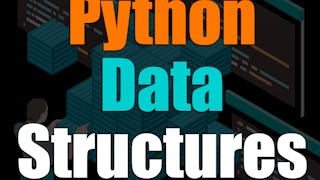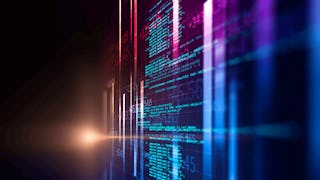Ce cours présente les principales structures de données du langage de programmation Python. Nous dépasserons les bases de la programmation procédurale et explorerons comment nous pouvons utiliser les structures de données intégrées à Python, telles que les listes, les dictionnaires et les tuples, pour effectuer des analyses de données de plus en plus complexes. Ce cours couvre les chapitres 6 à 10 du manuel "Python pour tous". Ce cours couvre Python 3.



Structure de données Python
Ce cours fait partie de Spécialisation Python pour tous

Instructeur : Charles Russell Severance
1 106 040 déjà inscrits
Inclus avec 
(96,606 avis)
Ce que vous apprendrez
Expliquer les principes des structures de données et leur utilisation
Créer des programmes capables de lire et d'écrire des données dans des fichiers
Stocker des données sous forme de paires clé/valeur à l'aide de dictionnaires Python
Réalisez des tâches en plusieurs étapes, telles que le tri ou le bouclage, à l'aide de tuples
Compétences que vous acquerrez
- Catégorie : Algorithmes
- Catégorie : Programmation Informatique
- Catégorie : Outils de programmation informatique
- Catégorie : Esprit Critique
- Catégorie : Analyse des Données
- Catégorie : structures de données
- Catégorie : Résolution de problèmes
- Catégorie : Principes de programmation
- Catégorie : Programmation en Python
- Catégorie : Génie logiciel
Détails à connaître

Ajouter à votre profil LinkedIn
5 devoirs
Découvrez comment les employés des entreprises prestigieuses maîtrisent des compétences recherchées

Élaborez votre expertise du sujet
- Apprenez de nouveaux concepts auprès d'experts du secteur
- Acquérez une compréhension de base d'un sujet ou d'un outil
- Développez des compétences professionnelles avec des projets pratiques
- Obtenez un certificat professionnel partageable


Obtenez un certificat professionnel
Ajoutez cette qualification à votre profil LinkedIn ou à votre CV
Partagez-le sur les réseaux sociaux et dans votre évaluation de performance

Il y a 7 modules dans ce cours
Dans ce cours, nous reprenons là où nous nous sommes arrêtés dans le cours précédent, en commençant par le chapitre 6 du manuel et en abordant les chaînes de caractères, puis les structures de données. La deuxième semaine de ce cours est consacrée à l'installation de Python si vous souhaitez exécuter les applications sur votre ordinateur de bureau ou portable. Si vous choisissez de ne pas installer Python, vous pouvez passer à la troisième semaine et prendre de l'avance.
Inclus
7 vidéos7 lectures1 devoir1 élément d'application
Dans ce module, vous mettrez tout en place pour pouvoir écrire des programmes Python. Il n'est pas nécessaire d'installer Python pour ce cours. Vous pouvez écrire et tester des programmes Python dans le navigateur en utilisant le "Python Code Playground" dans cette leçon. Veuillez lire le document "Utiliser Python dans ce cours" pour plus de détails.
Inclus
5 vidéos2 lectures1 évaluation par les pairs1 élément d'application
Jusqu'à présent, nous avons travaillé avec des données lues par l'utilisateur ou des données contenues dans des constantes. Mais les programmes réels traitent des quantités de données beaucoup plus importantes en lisant et en écrivant des fichiers sur la mémoire secondaire de votre ordinateur. Dans ce chapitre, nous commençons à écrire nos premiers programmes qui lisent, analysent et traitent des données réelles.
Inclus
5 vidéos1 lecture1 devoir2 éléments d'application
Pour résoudre des problèmes plus complexes en Python, nous avons besoin de variables plus puissantes. Jusqu'à présent, nous avons utilisé des variables simples pour stocker des nombres ou des chaînes de caractères, avec une seule valeur dans une variable. En commençant par les listes, nous stockerons plusieurs valeurs dans une seule variable en utilisant un schéma d'indexation pour stocker, organiser et récupérer différentes valeurs à l'intérieur d'une seule variable. Ces variables à valeurs multiples sont appelées "collections" ou "structures de données".
Inclus
7 vidéos1 devoir2 éléments d'application
Le dictionnaire Python est l'une des structures de données les plus puissantes. Au lieu de représenter les valeurs dans une liste linéaire, les dictionnaires stockent les données sous forme de paires clé/valeur. L'utilisation de paires clé/valeur nous donne une simple "base de données" en mémoire dans une seule variable Python.
Inclus
7 vidéos1 devoir1 élément d'application
Les tuples sont notre troisième et dernière structure de données de base en Python. Les tuples sont une version simple des listes. Nous utilisons souvent les tuples en conjonction avec les dictionnaires pour accomplir des tâches en plusieurs étapes, comme trier ou parcourir en boucle toutes les données d'un dictionnaire.
Inclus
6 vidéos1 devoir1 élément d'application
Pour fêter votre arrivée à mi-parcours de notre spécialisation Python pour tous, nous vous invitons à assister à notre cérémonie de remise des diplômes en ligne. Elle n'est pas très longue et comprend un orateur et un très court discours de remise des diplômes.
Inclus
2 vidéos2 lectures
Instructeur

Offert par
Recommandé si vous êtes intéressé(e) par Développement de logiciels


Coursera Project Network


University of Colorado Boulder


University of Pennsylvania
Préparer un diplôme
Pour quelles raisons les étudiants sur Coursera nous choisissent-ils pour leur carrière ?




Avis des étudiants
96 606 avis
- 5 stars
87,64 %
- 4 stars
11,18 %
- 3 stars
0,91 %
- 2 stars
0,13 %
- 1 star
0,12 %
Affichage de 3 sur 96606
Révisé le 18 juin 2020
Great course for pyhton. Loved this course and enjoyed it. Thanks to Dr.Chuck. If anyone who want to take a course which is well explained and fun for python learning, then Hey!!! this is your course.
Révisé le 9 nov. 2017
I feel incredible that I knew almost nothing about programming just a month ago. Now I have done two of the courses of the specialization and I can actually understand other basic codes. Great course!
Révisé le 16 nov. 2016
I really like this courses from Dr. Chuck. Just like previous course, this one has also been entertaining and interesting. I'm looking forward to the rest of courses in this specialization for Python.

Ouvrez de nouvelles portes avec Coursera Plus
Accès illimité à 10,000+ cours de niveau international, projets pratiques et programmes de certification prêts à l'emploi - tous inclus dans votre abonnement.
Faites progresser votre carrière avec un diplôme en ligne
Obtenez un diplôme auprès d’universités de renommée mondiale - 100 % en ligne
Rejoignez plus de 3 400 entreprises mondiales qui ont choisi Coursera pour les affaires
Améliorez les compétences de vos employés pour exceller dans l’économie numérique
Foire Aux Questions
L'accès aux cours et aux devoirs dépend de votre type d'inscription. Si vous suivez un cours en mode audit, vous pourrez consulter gratuitement la plupart des supports de cours. Pour accéder aux devoirs notés et obtenir un certificat, vous devrez acheter l'expérience de certificat, pendant ou après votre audit. Si vous ne voyez pas l'option d'audit :
Il se peut que le cours ne propose pas d'option d'audit. Vous pouvez essayer un essai gratuit ou demander une aide financière.
Le cours peut proposer l'option "Cours complet, pas de certificat" à la place. Cette option vous permet de consulter tous les supports de cours, de soumettre les évaluations requises et d'obtenir une note finale. Cela signifie également que vous ne pourrez pas acheter un certificat d'expérience.
Lorsque vous vous inscrivez au cours, vous avez accès à tous les cours de la Specializations, et vous obtenez un certificat lorsque vous terminez le travail. Votre certificat électronique sera ajouté à votre page de réalisations - de là, vous pouvez imprimer votre certificat ou l'ajouter à votre profil LinkedIn. Si vous souhaitez uniquement lire et visualiser le contenu du cours, vous pouvez auditer le cours gratuitement.
Si vous vous êtes abonné, vous bénéficiez d'une période d'essai gratuite de 7 jours pendant laquelle vous pouvez annuler votre abonnement sans pénalité. Après cette période, nous ne remboursons pas, mais vous pouvez résilier votre abonnement à tout moment. Consultez notre politique de remboursement complète.
Plus de questions
Aide financière disponible,




